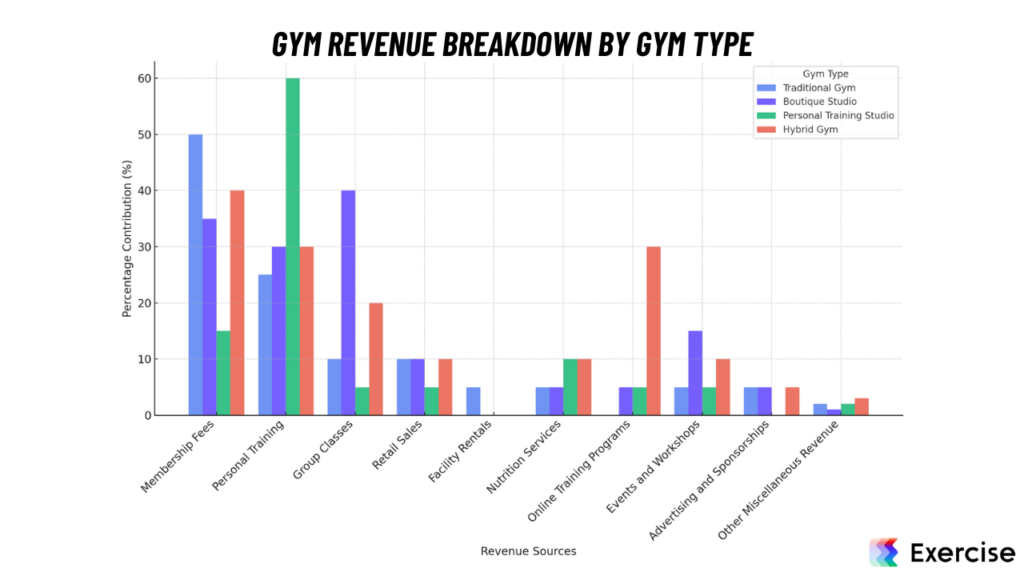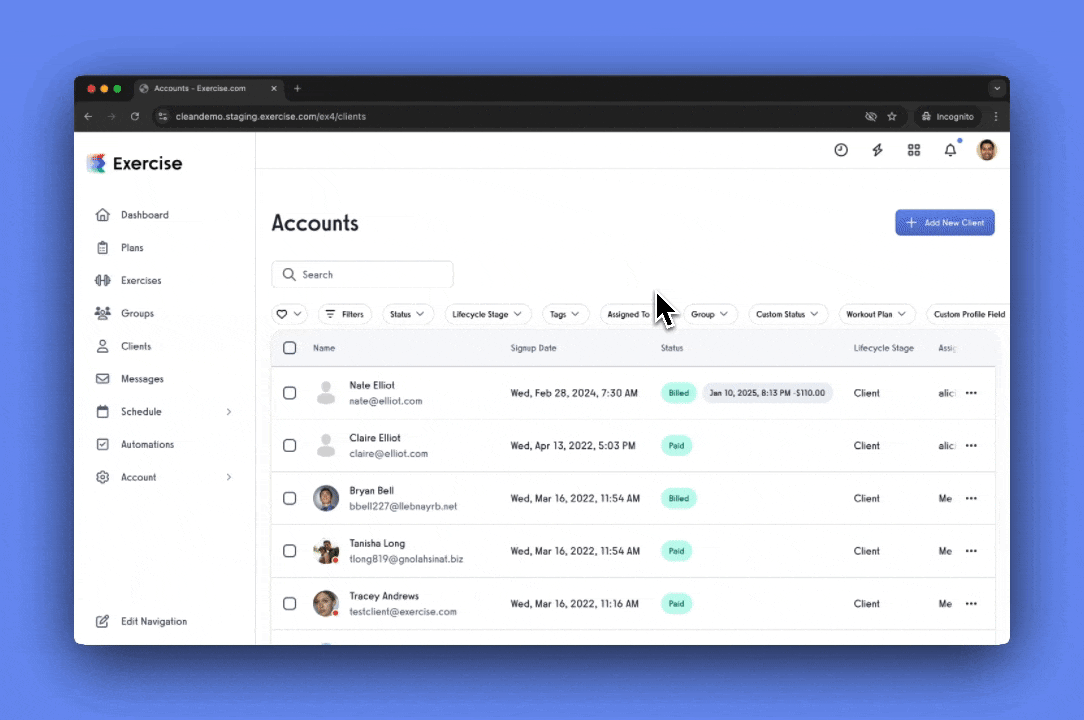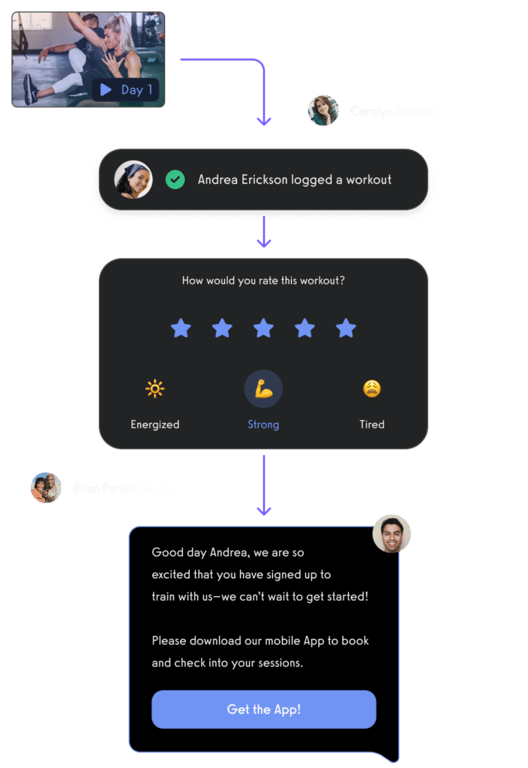Platform
Solutions
Industries
Compare
Resources
Posted by on January 30, 2023 — Updated on October 15, 2025
Gyms make money through gym memberships, personal training sessions, fitness classes, merchandise, and other products and services. See how gyms really make money—and grow yours with Exercise.com.

So how exactly do gyms make money? While the answer might seem obvious, the reality is a bit more nuanced. Yes, gyms make money from membership fees, but that’s just the beginning. Classes, personal training sessions, and merchandising also play a part (often, a large part). Different types of gyms also have different ways they make money. Discover add-on income sources that boost profits—powered by Exercise.com’s all-in-one platform.

No matter what the gym revenue stream or business model, Exercise.com can help gym owners increase gym revenue and profitability, increase gym member retention, and improve gym customer service with amazing software.
| Gym Revenue Stream | How Exercise.com Can Help |
|---|---|
| Membership Fees | Offers membership management features for tracking accounts, renewals, and attendance |
| Personal Training | Manages bookings, payments, and allows selling of training packages |
| Group Fitness Classes | Facilitates class scheduling, bookings, and attendance tracking |
| Online Training | Enables hosting of video sessions and selling of digital workout plans |
| Nutrition Counseling | Supports management and delivery of diet and nutrition plans |
| On-Demand Workout Videos | Allows creation and monetization of a library of on-demand workout videos |
| Fitness Challenges | Provides tools to manage and promote fitness challenges |
| Corporate Wellness Programs | Supports creation and management of corporate fitness offerings |
| Merchandise Sales | Can integrate with point-of-sale systems for gym-branded products |
| Specialized Workshops | Assists in scheduling and managing one-day events or seminars |
| Mobile App Subscriptions | Offers branded gym app with premium content capabilities |
| Performance Assessments | Provides tools for conducting and tracking fitness assessments |
Gyms make money through recurring memberships, personal training, and secondary revenue sources such as classes, retail, and digital programs. But the difference between a profitable gym and one struggling to stay afloat often comes down to how well these income streams are managed. Automated systems, accurate reporting, and integrated operations turn scattered processes into sustainable profit. The key is choosing the best gym management software that unifies billing, scheduling, and digital revenue tracking—so every member touchpoint drives measurable growth.
Understanding how gyms make money starts with reliable recurring revenue. Membership dues form the backbone of most gyms, but additional services like training packages, nutrition programs, and hybrid offerings drive long-term profitability. With the right tools, you can monitor ARPM (average revenue per member) and LTV (lifetime value) to track how price adjustments, new programs, or retention campaigns affect your bottom line. Learn more in how to increase gym revenue and profitability.
Many gyms also earn income from health and corporate fitness partnerships such as SilverSneakers, FitPass, or Active & Fit Direct. These programs reimburse participating gyms based on member check-ins, bringing consistent supplemental income. The challenge for operators is managing participation data and tracking reimbursements efficiently. While the payment models vary, software that can categorize members by program type, monitor utilization, and report visit counts accurately ensures every visit is accounted for and paid. Programs like SilverSneakers reward organized gyms with predictable recurring income and increased member traffic—especially when paired with streamlined automation and reporting systems.

Personal training and specialty programs often represent a gym’s highest-margin opportunities but are also the most underutilized. Without automation, trainers waste time on manual scheduling and payment tracking. Using insights from how to make money from fitness, successful gym owners bundle services into premium offerings, track staff utilization rates, and deliver workouts digitally. This converts one-on-one training into scalable hybrid and small-group revenue models that grow income without expanding overhead.
For gyms operating under different models—whether boutique fitness studios focused on premium pricing or commercial gyms built on high volume—the principles of profitability stay consistent. Efficiency, retention, and automation determine success. Centralized gym CRM systems, integrated communication tools, and automated billing processes give both types of gyms the foundation to scale without losing control of day-to-day operations. See why the best gym CRM software can help you scale your gym.

New owners often wonder, “is owning a gym passive income?” In reality, it only becomes passive once automation replaces manual management. When recurring billing, renewals, workout delivery, and member communication are handled by connected systems, the business begins to operate beyond the owner’s direct labor. See how profitable is owning a gym for a breakdown of how operators achieve this level of efficiency and stability.
Digital programs are another growing profit source for modern fitness businesses. Many operators now add online coaching, streaming memberships, or branded apps to diversify income beyond their physical location. Guides like how to make a fitness app explain how to integrate digital products into your business model, increasing reach and revenue potential without increasing fixed costs.


At the end of the day, are gyms profitable? Yes—when owners treat them like data-driven businesses instead of passion projects. Learning how to open a gym or exploring gym business models is only the first step. True profitability comes from integrating billing, analytics, retention, and marketing in one platform so you can measure, adjust, and grow confidently.
Ready to grow every revenue stream in your gym? Book a demo with Exercise.com today and see how the best gym management software transforms revenue tracking, billing automation, and digital expansion into long-term profit.
Read on to learn different ways gyms make money and how to create multiple gym revenue streams. Whether you are just learning how to open a gym or how to start a fitness business, or maybe you are a long-time gym owner and are always willing to learn and up your game, then check out this guide to learn all of the ways how gyms make money.
Then read through our gym owner guide, and learn how to make more money in the fitness industry with our free guide on how to make money from fitness, learn how to make a gym profitable with our guide on how to increase gym revenue and profitability, learn just how profitable are gym businesses exactly, and then let us help you manage your gym with the best gym software to run your entire gym in one place.
Use the best gym management software solution for managing a fast-growing gym: Exercise.com.
Robust booking and scheduling to maximize gym profitability.

Full gym ecommerce and the best gym payment processing software stack around with upsells, gym referral functionality, advanced package and session configurations, and key features to optimize and maximize your gym’s revenue and profitability.

Advanced reporting to give you the data you need to make more money with your gym.

And much, much more. All designed to help your gym make more money, increase gym member retention, and provide a world-class gym member experience (and gym staff experience) that will result in you having a successful gym business that can make money in-person and online.


If you’ve just opened a new gym (or are considering doing so), you’ve probably asked, “How do gyms make money?” The money earned from membership fees seems like the easy answer, but there’s a lot more to it than that.
As it turns out, gyms make money through a variety of methods, including retail, education, and technology (using tools like a gym CRM platform, a custom branded fitness app and a gym POS solution). Ready to maximize your gym’s earning potential? Get ready to offer multiple products and services to increase gym profitability. (Read more: How profitable is owning a gym?)
The gym revenue breakdown can differ significantly by gym type, depending on the gym business model, target audience, and services offered.

Here’s a comparison of how revenue sources typically vary among different types of gyms:
| Revenue Source | Traditional Gym | Boutique Studio | Personal Training Studio | Hybrid (Online & In-Person) |
|---|---|---|---|---|
| Membership Fees | High (40%-60%) | Moderate (30%-40%) | Low (10%-20%) | Moderate (30%-50%) |
| Personal Training | Moderate (20%-30%) | High (30%-40%) | High (50%-70%) | High (30%-40%) |
| Group Classes | Low (5%-10%) | High (40%-50%) | Low (5%-10%) | Moderate (20%-30%) |
| Retail Sales | Moderate (10%-15%) | Moderate (10%-15%) | Low (5%-10%) | Moderate (10%-15%) |
| Facility Rentals | Low (5%-10%) | Rarely Applicable | Rarely Applicable | Rarely Applicable |
| Nutrition Services | Low (5%-10%) | Low (5%-10%) | Moderate (10%-15%) | Moderate (10%-15%) |
| Online Training Programs | Rarely Applicable | Low (5%-10%) | Low (5%-10%) | High (20%-40%) |
| Events and Workshops | Low (5%-10%) | Moderate (10%-20%) | Low (5%-10%) | Moderate (10%-20%) |
| Advertising and Sponsorships | Low (5%-10%) | Low (5%-10%) | Rarely Applicable | Low (5%-10%) |
| Other Miscellaneous Revenue | Low (1%-5%) | Low (1%-5%) | Low (1%-5%) | Low (1%-5%) |
Read More:
There are three primary ways that gyms make money: from membership fees, from selling classes and personal training packages, and from selling extra goods and services.
The average cost of gym membership in the US is $507 per year, but every gym has its own income strategy. With memberships starting at $10 per month, Planet Fitness aims for a low-cost-high-volume approach. On the other hand, Life Time Fitness utilizes a more exclusive strategy, with memberships starting at $79 per month. According to the International Health, Racquet & Sportsclub Association (IHRSA), the average monthly membership fee for a gym in the United States is $58.
So, how much do gyms make from gym membership fees? The short answer is: it depends. The pricing structure you choose for your gym should make sense for your financial needs, but it should also compliment your company’s branding. It doesn’t make much sense to open a casual, fun, family gym if families can’t afford to frequent it. Conduct a gym SWOT analysis to decide how to make your gym stand out, and where your gym may intentionally choose not to compete.
Just because you set your gym’s membership fee at, for instance, $20 per month, it doesn’t mean you can’t play with that number to your advantage. If members are willing to pay for a year upfront, you could drop the cost to $15 per month.
Additionally, you could offer discounts for families or seniors. Conversely, in the name of reducing crowding during peak hours, you could charge a small fee to members who wish to use the gym during “premium hours”.
Whatever fee structure you choose for your gym, be sure to apply it consistently and fairly, and communicate any changes well in advance.
Read More:
Memberships may get customers in the door, but your gym’s earning potential does not stop there. Personal training packages are a perfect upgrade for members who may be new to working out, or for those who wish to maximize their results.
For other members who may be bored with their routine or who wish to have a more well-rounded fitness approach, classes are a great option. Yoga, pilates, and kettlebell classes are just a few examples that would fit well in nearly any gym (read our guide on ways to make money with yoga). According to the IHRSA, group exercise classes are the most popular type of class offered at health clubs, with an average of 10 classes offered per week. And the average revenue per class is $10-15.
Depending on your market and on your gym’s focus, you could even go a little more outside the box with your classes. Nutrition plans are a natural accompaniment to personal training packages. You could move your class outside to create a fitness boot camp.
With sports-specific training packages, you could attract high school and college athletes by helping them stay in shape for their sport during their off-season. You could even appeal to other fitness professionals by hosting fitness instructor training classes.
Read More: Personal Trainer Marketing
There is a whole world of goods and services that your gym can offer to enhance members’ experiences. If you have the space for it, you could include a smoothie bar, tanning beds, or a daycare area. If your gym has sports amenities, such as a basketball court or racquetball court, you could rent out equipment.
However, if space is tight, you can still sell things like supplements, bottled drinks, and branded merchandise (such as t-shirts and water bottles with your gym’s logo) using gym ecommerce software. And don’t forget about supplemental services like body composition testing and VO2 max testing.
According to the IHRSA, the average health club makes $2,600 in additional revenue from retail sales per month.
With the Exercise.com platform, we offer lightning fast online booking, one-click upsells to increase your average order value, and gym payment processing that will help you grow and manage your gym’s earning potential to the fullest.

While it can be tempting to start selling everything you can think of, it’s better to focus on a few additional gym revenue streams that make the most sense for your gym. Choose things that are easy to manage and will bring a great return. Dial in the best gym KPI metrics and then concentrate on what is most important to increase your gym income.
One simple tool that will show instant results is gym management software. Find one that can help track your revenue streams while also serving as an all-in-one information center, member portal, and online store. Streamline your gym with gym automations that send marketing messages to members and leads.

The fitness industry has expanded significantly over the years, allowing gyms and fitness centers to diversify their revenue streams. Here are 33 ways gyms can generate income:
Diversifying into multiple gym revenue streams can help gyms maintain financial stability, especially during times when traditional memberships might wane. With the increasing interest in health and wellness, there are numerous opportunities for gyms to monetize their services, especially when paired with comprehensive platforms like Exercise.com, which can manage multiple revenue streams effectively. You can sell workout plans online to make money, learn how to run a fitness challenge, offer online memberships in your custom-branded fitness apps, and much more—all from the best gym management software platform: Exercise.com.


The profitability of a gym can vary depending on various factors such as location, size, target market, competition, and effective business management. While some gyms can be highly profitable, others may struggle to generate significant profits. Offering additional services, such as personal training, group classes, or specialized programs, can contribute to increased revenue. It’s also essential to implement efficient business strategies, manage expenses effectively, and continuously adapt to meet the needs and preferences of the target market. Utilizing software solutions like Exercise.com can help streamline operations, automate tasks, and optimize revenue generation, leading to increased profitability for gym owners.
Read More: How profitable is owning a gym?
The earning potential for gym owners can vary significantly depending on several factors, including the size and success of the gym, the location, the target market, and the owner’s ability to effectively manage and grow the business. While some gym owners can generate substantial profits, it’s important to note that success is not guaranteed and can require significant effort, dedication, and strategic decision-making. Utilizing powerful software solutions like Exercise.com can help gym owners streamline their operations, automate administrative tasks, improve member engagement, and optimize revenue generation, ultimately contributing to the potential for increased earnings in the fitness industry.
Read More: How much money do gym owners make?
Gym owners typically earn income through various revenue streams, including membership fees, personal training sessions, group classes, retail sales, and additional services offered by the gym. The specific payment structure may vary depending on the business model, membership plans, and pricing options. Gym owners may receive payment through direct member payments, monthly or annual contracts, electronic funds transfer, credit card payments, or other payment processing systems. Effective financial management, including accurate tracking of revenue and expenses, is crucial for gym owners to ensure a stable and profitable business.
Read More: Gym Owner Average Salary Chart
Yes, a small gym can make money and be profitable. The key to success lies in effective management, strategic planning, and providing value to members. By focusing on providing high-quality services, cultivating a strong community, and implementing efficient business practices, small gyms can attract and retain members, leading to consistent revenue generation. Utilizing software solutions like Exercise.com can help small gym owners optimize their operations, automate processes, enhance member experience, and streamline revenue management, contributing to the profitability of the business. Learn more about how to start a small gym and be sure to use the best gym management software platform with Exercise.com so that you can grow and scale your gym.
The revenue generated by gyms can vary significantly based on several factors, including the size of the facility, the location, the target market, and the business model. Large fitness chains and franchises with widespread locations and established brand recognition often have the potential to generate higher revenue. However, it’s important to note that the financial success of a gym is not solely determined by its size or brand name. Effective business management, innovative services, strategic marketing, and a strong focus on member satisfaction are all factors that can contribute to a gym’s financial success. Utilizing software solutions like Exercise.com can help gym owners optimize their revenue generation and business operations, regardless of their size or brand.
Read More: The Most Successful Gyms in America
The number of members required for a gym to be successful can vary depending on several factors, including the size of the facility, the pricing structure, the operating expenses, and the target market. While there is no fixed number that guarantees success, gyms typically aim to attract and retain a sufficient number of members to cover their operating costs, generate profit, and sustain long-term growth. The specific membership count will vary based on the business model and financial goals of the gym. Effective marketing strategies, exceptional member experience, and utilizing software solutions like Exercise.com can help gyms attract and retain members, contributing to their overall success.
Gyms make money with personal training by offering these services at a premium. Personal trainers typically work either as employees or independent contractors within the gym, and the gym charges members for one-on-one sessions. The rates for personal training are significantly higher than standard membership fees, and gyms often take a percentage of the session fees, contributing substantially to their revenue.
Gyms become profitable by diversifying their revenue streams beyond just membership fees. This includes income from personal training sessions, group classes, merchandise sales, and additional services like childcare, spa services, and cafés. Efficient management of operational costs such as staff, equipment maintenance, and utilities also plays a crucial role in maintaining profitability.
Gyms make a profit by maximizing the utilization of their space and services to increase revenue while controlling operational costs. Profit drivers include membership sales, personal training, group fitness classes, and ancillary services like nutrition counseling, massage therapy, and health shops selling supplements and gym gear. Successful gyms also focus on member retention to ensure a steady income flow.
Active and Fit compensation to gyms is typically based on a negotiated rate per member visit or a flat monthly fee for each enrolled member, but the exact amounts can vary widely depending on the gym’s agreement with Active and Fit. These payments provide gyms with an additional revenue stream while encouraging gym usage among Active and Fit members.
Gyms can start making money on SilverSneakers almost immediately after enrolling in the program and accepting members. Compensation is usually based on member check-ins; the more a SilverSneakers member uses the facility, the more the gym earns. This program also indirectly contributes to profitability by increasing foot traffic and potential upselling of other services.
Gyms often experience a significant increase in revenue in January due to New Year’s resolutions, with many people signing up for memberships as part of their fitness goals. This surge can result in higher sales compared to other months, both in terms of new memberships and increased interest in personal training and classes. However, sustaining this influx throughout the year is key to maintaining profitability.
To make money owning a gym, focus on creating a strong value proposition to attract and retain members, diversify revenue streams beyond membership fees, and manage operational costs efficiently. Implementing effective marketing strategies, offering a variety of services like personal training and group classes, and maintaining high-quality facilities can also significantly contribute to a gym’s financial success.
Gym franchises have the potential to be profitable, but success is not guaranteed solely by being part of a franchise. The profitability of a gym franchise depends on various factors, including the specific franchise brand, the location, the market competition, the quality of management, and the ability to attract and retain members. While some gym franchises may be highly successful and generate significant profits, others may face challenges and struggle to achieve financial success. Effective business strategies, strong brand reputation, exceptional customer experience, and utilizing software solutions like Exercise.com can help gym franchises optimize their operations and revenue generation, increasing the potential for financial success.
Read More:
Gyms become profitable by balancing operational costs with diverse revenue streams. Profitability is achieved through membership fees, personal training services, group classes, selling merchandise, and additional amenities like spas or cafés. Effective gym marketing, member retention strategies, and efficient use of resources also contribute to gym profitability. You can make your gym profitable by committing to increasing revenue while decreasing expenses.
Read More: How to Increase Gym Revenue and Profitability
Gym owners make money primarily through membership fees, which can be on a monthly, quarterly, or annual basis. Other significant income sources include personal training sessions, group fitness classes, selling fitness-related merchandise, hosting events or workshops, and offering additional health and wellness services.
The profitability of gyms varies widely based on factors like location, size, target market, and services offered. Some gyms, especially those with a unique selling proposition or located in high-demand areas, can be quite profitable. However, success in the fitness industry often requires careful financial planning and market analysis.
The average gym profit margin is 10-15%, with franchise gym profits on the lower end of 10%, boutique fitness studios averaging 20% to even 40% profit margins, and CrossFit gym profit margins in the 25-30% range. This variance is influenced by factors such as gym size, location, membership pricing, operating costs, and the range of services offered. Smaller boutique gyms might have higher margins due to specialized offerings, while larger gyms might operate on lower margins but with higher volume. So, what is the average profit of a gym? It varies. But why not have your gym beat the average!
Read More: Average Gym Profit Margin
Legal requirements for opening a gym include:
Read More:
The cost of opening a gym can vary widely depending on several factors, including the size and location of the facility, the equipment and amenities, lease or purchase costs, interior design, staffing requirements, marketing expenses, and other startup costs. The total investment can range from tens of thousands to hundreds of thousands of dollars or more. It’s essential to conduct thorough market research, create a detailed business plan, and secure adequate funding to cover both startup and ongoing operational expenses. Utilizing software solutions like Exercise.com can help gym owners optimize their financial management and streamline operations, contributing to cost-effectiveness and financial success. So, what is the cost of building a gym? The cost of building a gym depends on the gym’s size and scope. It can range from around $50,000 for a basic setup in a small space to over $1 million for a large, high-end facility. Costs include purchasing equipment, flooring, mirrors, sound systems, and potentially expenses for building modifications.
Read More:
The average gym startup cost varies greatly but can range from $10,000 for a small personal training studio to several hundred thousand dollars for a fully equipped commercial gym. Costs include equipment, leasing or purchasing space, renovations, initial marketing, and operational setup.
The minimum investment to start a gym can vary widely depending on several factors such as location, size of the facility, type of gym (boutique, commercial, specialized), and the level of equipment and amenities you plan to offer. However, to give a general idea:
These estimates include costs for:
It’s important to conduct thorough market research and financial planning to estimate the costs accurately for your specific gym concept and location. Additionally, consider initial capital to sustain the business until it becomes profitable, as it might take some time to build up a steady membership base.
Read More: Cost to Open a Gym
The monthly cost of running a gym includes rent or mortgage payments, utilities, staff salaries, equipment maintenance, insurance, marketing, and other operational expenses. This can range from a few thousand dollars for a small gym to tens of thousands for larger facilities. Managing these costs efficiently is crucial for maintaining profitability.
Read More: What is the monthly cost of running a gym?
Generating immediate revenue when opening a gym can be challenging, as it takes time to attract and retain members, establish a strong brand presence, and build a loyal customer base. The initial period after opening a gym often involves significant investment in marketing, infrastructure setup, and member acquisition efforts. It’s crucial to have a solid business plan, financial reserves, and a realistic understanding of the time it takes to reach profitability. Leveraging software solutions like Exercise.com can help streamline operations, automate administrative tasks, and enhance member experience, contributing to revenue generation and accelerating the path to financial sustainability.
To make a gym profitable, several strategies can be employed. First, attracting and retaining members is crucial, so offering high-quality services, creating a positive and engaging atmosphere, and building strong relationships with members are essential. Second, diversifying revenue streams by offering additional services such as personal training, group classes, specialized programs, or retail sales can contribute to increased revenue. Third, effective cost management, including optimizing expenses, negotiating favorable supplier contracts, and leveraging technology to streamline operations, can improve profitability. Fourth, implementing strategic marketing and promotional campaigns to attract new members and retain existing ones is vital. Utilizing software solutions like Exercise.com can support gym owners in optimizing their operations, automating processes, enhancing member experience, and ultimately increasing profitability. Be sure and use the best white label fitness app software coupled with the best gym ecommerce software to offer a premium branded online experience along with your in-person gym experience for a diversified gym revenue stream.
Read More:
There are several ways to make money in the fitness industry. One common avenue is operating a gym or fitness facility, offering memberships and additional services such as personal training, group classes, or specialized programs. Another option is becoming a personal trainer or fitness coach, providing one-on-one or group training sessions. Online fitness coaching and digital products, such as workout programs or nutrition guides, have also gained popularity and can be monetized. Fitness professionals can also generate income through teaching fitness classes, hosting workshops or seminars, writing fitness-related books or articles, or becoming fitness influencers. Utilizing software solutions like Exercise.com can help fitness professionals optimize their business operations, attract clients, and maximize revenue generation in the fitness industry.
Read More: How to Make Money from Fitness
Yes, gyms can be profitable businesses. Their profitability depends on factors like location, membership retention, quality of services, and effective management. Offering a range of services such as personal training, group classes, and additional amenities can significantly boost revenue. Proper business planning and a good understanding of the fitness market are essential for success.
Boutique or specialized gyms tend to be more profitable than traditional gyms. These gyms focus on specific fitness niches like yoga, pilates, or high-intensity interval training (HIIT), often allowing for higher membership fees due to specialized services. Additionally, they often require less space and equipment than a full-service gym, reducing overhead costs.
Read More:
Cheap gyms, like budget-friendly fitness chains, make money through high volume. They attract a large number of members with low-cost memberships, banking on the fact that not all members will use the gym regularly. They also profit from additional services like personal training, group classes, and selling merchandise.
Yes, small gyms can make money, especially if they target a specific niche or offer specialized services that are not available in larger gyms. Effective management, local marketing, and a strong community presence can significantly contribute to a small gym’s profitability.
Owning a gym typically isn’t considered passive income since it involves active management, whether it’s handling day-to-day operations, managing staff, or marketing the business. However, with a strong management team and systems in place, it can provide a more passive income stream for the owner.
Read More: Is owning a gym passive income?
Gyms often make the most money in January when New Year’s resolutions drive sign-ups, and in the late spring or early summer when people want to improve their fitness for the summer season. These periods are prime times for gyms to offer promotions and special deals to attract new members.
Gym influencers make money through various channels like sponsored content, affiliate marketing, selling their own fitness programs or merchandise, collaborations with fitness brands, and offering personal training services. Their income is often directly related to their social media presence and engagement.
Owning a gym can be challenging due to factors like competition, high initial investment, ongoing maintenance costs, and the need for constant innovation to keep members engaged. Success requires good business acumen, a deep understanding of the fitness market, and effective strategies for member retention.
Owning a gym can be a good business idea if you have a clear understanding of your target market, effective business and financial planning, and a passion for fitness and wellness. The success of a gym business depends on its ability to attract and retain members, offer quality services, and adapt to changing fitness trends.
The hardest part of owning a gym is often managing the financial aspects, such as controlling operational costs, maintaining cash flow, and achieving profitability. Other challenges include member retention, staying competitive in a saturated market, and continuously updating equipment and services to meet customer expectations.
Read More: Pros and Cons of Owning a Gym
To start a successful gym business:
Read More: How to Have a Successful Gym Business
The primary revenue streams for gyms include membership fees, personal training sessions, group classes, merchandise sales, and rental fees for special events or facility use. Some gyms may also offer additional services such as spa treatments, childcare, or nutrition coaching to generate extra income.
Membership fees are the foundation of a gym’s revenue, with clients typically paying on a monthly, quarterly, or annual basis. Offering different membership tiers and contract lengths can attract a broader range of customers, ensuring a steady flow of income for the gym.
Gyms profit from personal training sessions by taking a percentage of the fee paid by clients for one-on-one sessions with certified trainers. This revenue stream not only benefits the gym financially but also adds value to memberships by providing clients with tailored fitness guidance.
Group classes can be a significant revenue generator for gyms, as they often attract additional fees on top of regular memberships. Offering a diverse range of classes, such as yoga, spinning, or HIIT, can cater to different interests and fitness levels, encouraging more clients to participate and boosting income.
Gyms can generate income from merchandise sales by offering branded clothing, fitness accessories, supplements, and snacks for purchase. Providing high-quality products and ensuring they are prominently displayed within the gym can increase sales and contribute to the gym’s overall revenue.
Rental fees can be a lucrative source of income for gyms, as they may rent out facilities for special events, workshops, or sports competitions. Additionally, some gyms may rent space to independent fitness professionals, such as personal trainers or group class instructors, further diversifying their revenue streams.
Gyms can generate extra income by offering additional services, such as massage therapy, tanning, nutrition counseling, or childcare. These services not only provide added convenience for gym-goers but also increase the perceived value of memberships, making clients more likely to invest in higher-tier plans.
Gyms can attract and retain members by offering competitive pricing, a diverse range of fitness options, and exceptional customer service. Additionally, creating a welcoming atmosphere, hosting member appreciation events, and implementing referral programs can help gyms maintain a loyal clientele and increase revenue.
Gyms can establish corporate partnerships with local businesses to offer discounted memberships or wellness programs for employees. These partnerships can lead to a steady stream of new clients and provide additional revenue opportunities through group training or team-building activities.
Gyms make money from ClassPass through a partnership model. When ClassPass members book a class at a gym, ClassPass pays the gym a predetermined rate per attendance. Although this rate might be lower than the gym’s standard drop-in fee, it allows gyms to fill classes that might otherwise have empty spots, thus optimizing their revenue and reaching a wider customer base.
Similar to ClassPass, Gympass operates on a partnership model. Gyms receive compensation from Gympass each time a Gympass member attends a class or uses the gym facilities. This partnership exposes gyms to a broader range of potential members, including those who may not commit to a traditional gym membership but use Gympass for its flexibility.
Active and Fit partners with gyms to provide affordable access to its members. The gyms are compensated based on member visits. While the per-visit rate may be lower than the gym’s standard fee, partnering with Active and Fit can lead to increased overall usage, especially during off-peak hours, and potentially attract long-term members.
Silver Sneakers is a fitness program primarily for seniors, and it partners with gyms across the country. Gyms are reimbursed based on Silver Sneakers member attendance. This program allows gyms to tap into the senior market, which might not be as price-sensitive as other demographics, and can also contribute to more consistent off-peak hour attendance.
Silver Sneakers is a fitness program designed specifically for older adults, typically aged 65 and up, to promote health, wellness, and an active lifestyle. The program partners with fitness facilities, gyms, and community centers to offer free or low-cost access to exercise classes, gym equipment, and other wellness activities for eligible members.
Silver Sneakers works through Medicare Advantage or Medicare Supplement plans. If your health insurance plan includes Silver Sneakers, you can enroll at no extra cost. Once enrolled, you receive a membership that grants access to participating fitness locations and a range of group fitness classes tailored to older adults, including yoga, strength training, and cardio exercises. Many facilities also offer social activities to foster community engagement among participants.
For gyms and fitness businesses, partnering with Silver Sneakers can attract a steady stream of senior members and diversify their clientele. Using a gym management platform like Exercise.com can help streamline the process of managing memberships, scheduling classes, and tracking participation for programs like Silver Sneakers.
Fitness Passport works by offering a corporate membership program that employees can use at various gyms. Each gym that partners with Fitness Passport receives payment based on the number of visits by Fitness Passport holders. This scheme helps gyms gain exposure to corporate clients and increase utilization rates without significant marketing expenses.
Planet Fitness’s business model is based on high-volume, low-cost memberships. The $10 per month fee attracts a large number of members, many of whom may not regularly use the gym. The revenue is supplemented by selling higher-tier memberships, offering personal training sessions, merchandise, and leveraging partnerships. Additionally, their low-cost model helps maintain low overhead costs, and the high number of members ensures steady revenue, even if individual contributions are small. This strategy, combined with efficient operations and targeted marketing, allows Planet Fitness to be profitable despite low individual membership fees.
Read More: Planet Fitness Business Model
24 Hour Fitness makes money primarily through its membership fees, offering various membership plans that cater to different customer needs. Their business model includes:
The combination of these revenue streams enables 24 Hour Fitness to maintain profitability while offering round-the-clock access to their gym facilities. Their ability to cater to a broad customer base with different fitness needs and preferences is key to their business model.
At the end of the day, there is no one single way that gyms make money. Membership fees are just the beginning, and the possibilities are endless. So get thinking, because your gym’s earning potential may only be limited by your creativity.
If you’re ready to add additional revenue streams to your gym’s operation, Exercise.com can help. Book a demo to learn more.


 Tyler Spraul
Tyler Spraul 




